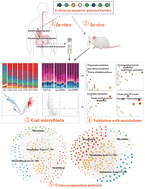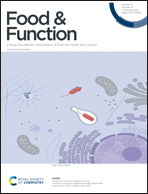The combination of microbiome and metabolome to analyze the cross-cooperation mechanism of Echinacea purpurea polysaccharide with the gut microbiota in vitro and in vivo†
Abstract
Echinacea purpurea polysaccharide (EPP) is a functional compound in Echinacea purpurea. At present, it is generally recognized that plant polysaccharides can regulate the intestinal microecology, but there are few studies on EPP. In this study, we used the digestive model (stomach–small intestine–colon) and a mouse model to study the effect of EPP on intestinal microecology and the mechanism. Also, combined with the microbiome and metabolome analysis methods, the interaction network mechanism of EPP–gut microbiota–metabolites–metabolism was investigated. After EPP was digested by human intestinal microbiota, the microbial diversity changed, with an increase in the relative abundance of Bifidobacterium and a decrease in the abundance of Prevotella, Catenibacterium and Ruminococcus torques. After metabolism in mice, the concentration of short-chain fatty acids increased, the abundances of Muribaculaceae and Alloprevotella increased, and those of Lachnospiraceae and Butyricicoccus decreased. Both in vivo and in vitro experiments revealed that EPP can downregulate the expression of 15 enzymes involved in porphyrin metabolism. In addition, the metabolome results also confirmed that alanine metabolism, phenylalanine, tyrosine and tryptophan biosynthesis, and glycine, serine and threonine metabolism are regulatory pathways of EPP. Tryptophan, ornithine, tyrosine, leucine, alanine and serine are hallmark metabolites. The cross-cooperation network greatly influenced the microbiota (Lactobacillus, Lachnospiraceae), metabolites (tryptophan, beta-D-fructose 1,6-bisphosphate), and metabolism (glycosphingolipid biosynthesis), suggesting that they may be the key factors mediating the metabolic function of EPP. Therefore, EPP has the effect of enhancing the proliferation of gut-beneficial bacteria that metabolize polysaccharides and produce valuable metabolites.



 Please wait while we load your content...
Please wait while we load your content...